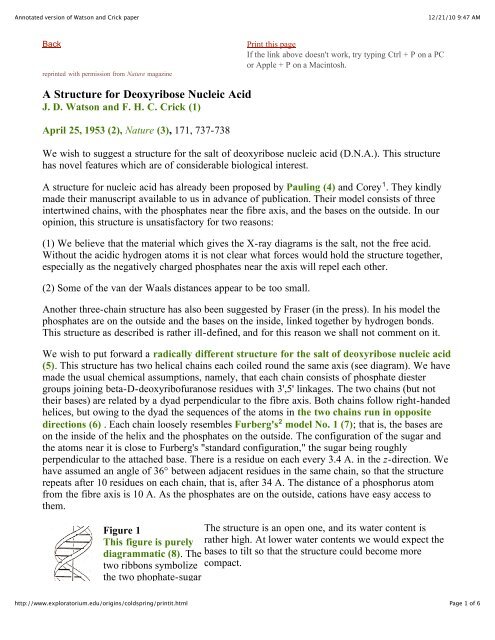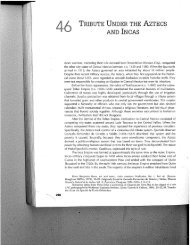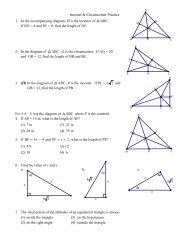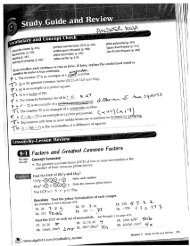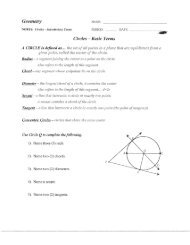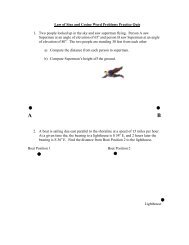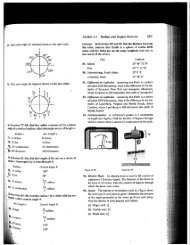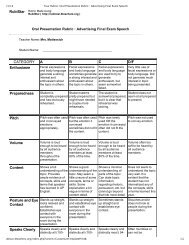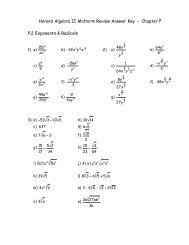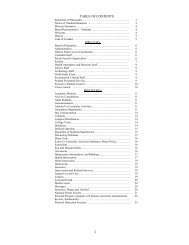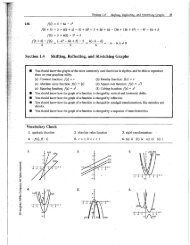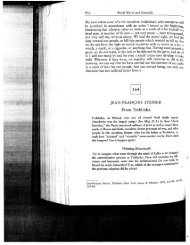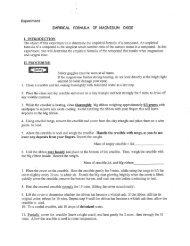Annotated version of Watson and Crick paper
Annotated version of Watson and Crick paper
Annotated version of Watson and Crick paper
- No tags were found...
You also want an ePaper? Increase the reach of your titles
YUMPU automatically turns print PDFs into web optimized ePapers that Google loves.
<strong>Annotated</strong> <strong>version</strong> <strong>of</strong> <strong>Watson</strong> <strong>and</strong> <strong>Crick</strong> <strong>paper</strong>12/21/10 9:47 AMBackreprinted with permission from Nature magazinePrint this pageIf the link above doesn't work, try typing Ctrl + P on a PCor Apple + P on a Macintosh.A Structure for Deoxyribose Nucleic AcidJ. D. <strong>Watson</strong> <strong>and</strong> F. H. C. <strong>Crick</strong> (1)April 25, 1953 (2), Nature (3), 171, 737-738We wish to suggest a structure for the salt <strong>of</strong> deoxyribose nucleic acid (D.N.A.). This structurehas novel features which are <strong>of</strong> considerable biological interest.A structure for nucleic acid has already been proposed by Pauling (4) <strong>and</strong> Corey 1 . They kindlymade their manuscript available to us in advance <strong>of</strong> publication. Their model consists <strong>of</strong> threeintertwined chains, with the phosphates near the fibre axis, <strong>and</strong> the bases on the outside. In ouropinion, this structure is unsatisfactory for two reasons:(1) We believe that the material which gives the X-ray diagrams is the salt, not the free acid.Without the acidic hydrogen atoms it is not clear what forces would hold the structure together,especially as the negatively charged phosphates near the axis will repel each other.(2) Some <strong>of</strong> the van der Waals distances appear to be too small.Another three-chain structure has also been suggested by Fraser (in the press). In his model thephosphates are on the outside <strong>and</strong> the bases on the inside, linked together by hydrogen bonds.This structure as described is rather ill-defined, <strong>and</strong> for this reason we shall not comment on it.We wish to put forward a radically different structure for the salt <strong>of</strong> deoxyribose nucleic acid(5). This structure has two helical chains each coiled round the same axis (see diagram). We havemade the usual chemical assumptions, namely, that each chain consists <strong>of</strong> phosphate diestergroups joining beta-D-deoxyrib<strong>of</strong>uranose residues with 3',5' linkages. The two chains (but nottheir bases) are related by a dyad perpendicular to the fibre axis. Both chains follow right-h<strong>and</strong>edhelices, but owing to the dyad the sequences <strong>of</strong> the atoms in the two chains run in oppositedirections (6) . Each chain loosely resembles Furberg's 2 model No. 1 (7); that is, the bases areon the inside <strong>of</strong> the helix <strong>and</strong> the phosphates on the outside. The configuration <strong>of</strong> the sugar <strong>and</strong>the atoms near it is close to Furberg's "st<strong>and</strong>ard configuration," the sugar being roughlyperpendicular to the attached base. There is a residue on each every 3.4 A. in the z-direction. Wehave assumed an angle <strong>of</strong> 36° between adjacent residues in the same chain, so that the structurerepeats after 10 residues on each chain, that is, after 34 A. The distance <strong>of</strong> a phosphorus atomfrom the fibre axis is 10 A. As the phosphates are on the outside, cations have easy access tothem.Figure 1The structure is an open one, <strong>and</strong> its water content isThis figure is purely rather high. At lower water contents we would expect thediagrammatic (8). The bases to tilt so that the structure could become moretwo ribbons symbolize compact.the two phophate-sugarhttp://www.exploratorium.edu/origins/coldspring/printit.htmlPage 1 <strong>of</strong> 6
<strong>Annotated</strong> <strong>version</strong> <strong>of</strong> <strong>Watson</strong> <strong>and</strong> <strong>Crick</strong> <strong>paper</strong>12/21/10 9:47 AM1Pauling, L., <strong>and</strong> Corey, R. B., Nature, 171, 346 (1953); Proc. U.S. Nat. Acad. Sci., 39, 84 (1953).2Furberg, S., Acta Chem. Sc<strong>and</strong>., 6, 634 (1952).3Chargaff, E., for references see Zamenh<strong>of</strong>, S., Brawerman, G., <strong>and</strong> Chargaff, E., Biochim. et Biophys. Acta, 9, 402(1952).4Wyatt, G. R., J. Gen. Physiol., 36, 201 (1952).5Astbury, W. T., Symp. Soc. Exp. Biol. 1, Nucleic Acid, 66 (Camb. Univ. Press, 1947).6Wilkins, M. H. F., <strong>and</strong> R<strong>and</strong>all, J. T., Biochim. et Biophys. Acta, 10, 192 (1953).Annotations(1) It’s no surprise that James D. <strong>Watson</strong> <strong>and</strong> Francis H. C. <strong>Crick</strong> spoke <strong>of</strong> finding the structure <strong>of</strong> DNAwithin minutes <strong>of</strong> their first meeting at the Cavendish Laboratory in Cambridge, Engl<strong>and</strong>, in 1951. <strong>Watson</strong>,a 23-year-old geneticist, <strong>and</strong> <strong>Crick</strong>, a 35-year-old former physicist studying protein structure for hisdoctorate in biophysics, both saw DNA’s architecture as the biggest question in biology. Knowing thestructure <strong>of</strong> this molecule would be the key to underst<strong>and</strong>ing how genetic information is copied. In turn, thiswould lead to finding cures for human diseases.Aware <strong>of</strong> these pr<strong>of</strong>ound implications, <strong>Watson</strong> <strong>and</strong> <strong>Crick</strong> were obsessed with the problem—<strong>and</strong>, perhapsmore than any other scientists, they were determined to find the answer first. Their competitive spirit drovethem to work quickly, <strong>and</strong> it undoubtedly helped them succeed in their quest.<strong>Watson</strong> <strong>and</strong> <strong>Crick</strong>’s rapport led them to speedy insights as well. They incessantly discussed the problem,bouncing ideas <strong>of</strong>f one another. This was especially helpful because each one was inspired by differentevidence. When the visually sensitive <strong>Watson</strong>, for example, saw a cross-shaped pattern <strong>of</strong> spots in an X-ray photograph <strong>of</strong> DNA, he knew DNA had to be a double helix. From data on the symmetry <strong>of</strong> DNAcrystals, <strong>Crick</strong>, an expert in crystal structure, saw that DNA’s two chains run in opposite directions.Since the groundbreaking double helix discovery in 1953, <strong>Watson</strong> has used the same fast, competitiveapproach to propel a revolution in molecular biology. As a pr<strong>of</strong>essor at Harvard in the 1950s <strong>and</strong> 1960s,<strong>and</strong> as past director <strong>and</strong> current president <strong>of</strong> Cold Spring Harbor Laboratory, he tirelessly built intellectualarenas—groups <strong>of</strong> scientists <strong>and</strong> laboratories—to apply the knowledge gained from the double helixdiscovery to protein synthesis, the genetic code, <strong>and</strong> other fields <strong>of</strong> biological research. By relentlesslypushing these fields forward, he also advanced the view among biologists that solving major healthproblems requires research at the most fundamental level <strong>of</strong> life.(2) On this date, Nature published the <strong>paper</strong> you are reading.According to science historian Victor McElheny <strong>of</strong> the Massachusetts Institute <strong>of</strong> Technology, this date wasa turning point in a longst<strong>and</strong>ing struggle between two camps <strong>of</strong> biology, vitalism <strong>and</strong> reductionism. Whilevitalists studied whole organisms <strong>and</strong> viewed genetics as too complex to underst<strong>and</strong> fully, reductionists sawdeciphering fundamental life processes as entirely possible—<strong>and</strong> critical to curing human diseases. Thediscovery <strong>of</strong> DNA’s double-helix structure was a major blow to the vitalist approach <strong>and</strong> gave momentum tothe reductionist field <strong>of</strong> molecular biology.Historians wonder how the timing <strong>of</strong> the DNA race affected its outcome. Science, after years <strong>of</strong> beingdiverted to the war effort, was able to focus more on problems such as those affecting human health. Yet,in the United States, it was threatened by a curb on the free exchange <strong>of</strong> ideas. Some think that Americanresearcher Linus Pauling would have beaten <strong>Watson</strong> <strong>and</strong> <strong>Crick</strong> to the punch if Pauling’s ability to travel hadnot been hampered in 1952 by the overzealous House Un-American Activities Committee.(3) Nature (founded in 1869)——<strong>and</strong> hundreds <strong>of</strong> other scientific journals—help push science forward byproviding a venue for researchers to publish <strong>and</strong> debate findings. Today, journals also validate the quality <strong>of</strong>this research through a rigorous evaluation called peer review. Generally at least two scientists, selected bythe journal’s editors, judge the quality <strong>and</strong> originality <strong>of</strong> each <strong>paper</strong>, recommending whether or not it shouldbe published.http://www.exploratorium.edu/origins/coldspring/printit.htmlPage 3 <strong>of</strong> 6
<strong>Annotated</strong> <strong>version</strong> <strong>of</strong> <strong>Watson</strong> <strong>and</strong> <strong>Crick</strong> <strong>paper</strong>12/21/10 9:47 AMTo read more about Rosalind Franklin <strong>and</strong> her history with Wilkins, <strong>Watson</strong>, <strong>and</strong> <strong>Crick</strong>, see the following:“Light on a Dark Lady” by Anne Piper, a lifelong friend <strong>of</strong> Franklin’sURL: http://www.physics.ucla.edu/~cwp/articles/franklin/piper.html“The Double Helix <strong>and</strong> the Wronged Heroine,” an essay on Nature’s “Double Helix: 50 years <strong>of</strong> DNA” WebsiteURL: http://www.nature.com/cgi-taf/DynaPage.taf?file=/nature/journal/v421/n6921/full/nature01399_fs.htmlA review <strong>of</strong> Brenda Maddox’s recent book, Rosalind Franklin: The Dark Lady <strong>of</strong> DNA in The Guardian (UK)URL: http://books.guardian.co.uk/whitbread2002/story/0,12605,842764,00.html(12) This phrase <strong>and</strong> the sentence it begins may be one <strong>of</strong> the biggest understatements in biology. <strong>Watson</strong><strong>and</strong> <strong>Crick</strong> realized at the time that their work had important scientific implications beyond a “prettystructure.” In this statement, the authors are saying that the base pairing in DNA (adenine links to thymine<strong>and</strong> guanine to cytosine) provides the mechanism by which genetic information carried in the double helixcan be precisely copied. Knowledge <strong>of</strong> this copying mechanism started a scientific revolution that wouldlead to, among other advances in molecular biology, the ability to manipulate DNA for genetic engineering<strong>and</strong> medical research, <strong>and</strong> to decode the human genome, along with those <strong>of</strong> the mouse, yeast, fruit fly,<strong>and</strong> other research organisms.(13) This <strong>paper</strong> is short because it was intended only to announce <strong>Watson</strong> <strong>and</strong> <strong>Crick</strong>’s discovery, <strong>and</strong>because they were in a competitive situation. In January 1954, they published the “full details” <strong>of</strong> their workin a longer <strong>paper</strong> (in Proceedings <strong>of</strong> the Royal Society). This “expound later” approach was usual inscience in the 1950s as it continues to be. In fact, Rosalind Franklin did the same thing, supplementing hershort April 25 <strong>paper</strong> with two longer articles.Today, scientists publish their results in a variety <strong>of</strong> formats. They also present their work at conferences.<strong>Watson</strong> reported his <strong>and</strong> <strong>Crick</strong>’s results at the prestigious annual symposium at Cold Spring HarborLaboratory in June 1953. As part <strong>of</strong> our recognition <strong>of</strong> the fiftieth anniversary <strong>of</strong> the double helix discovery,we will join scientists at Cold Spring Harbor as they present their <strong>paper</strong>s at the “Biology <strong>of</strong> DNA”conference.© exploratoriumhttp://www.exploratorium.edu/origins/coldspring/printit.htmlPage 6 <strong>of</strong> 6


